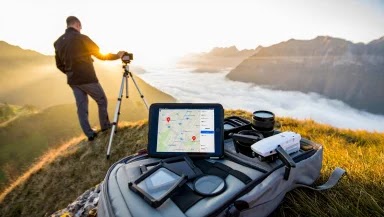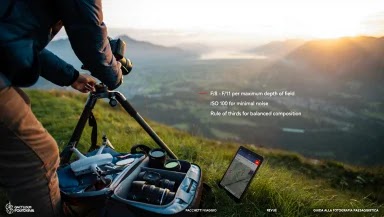In today’s visually saturated world, creating content that truly captivates an audience has become increasingly challenging. Many content creators find themselves frustrated when their landscape footage falls flat, lacking the emotional impact and professional quality needed to stand out. This disconnect between vision and execution is particularly painful when capturing breathtaking landscapes – scenes that should inherently inspire awe often appear mundane when poorly filmed. If you’ve struggled with this disconnect, you’re not alone. Working with a real estate video company that understands the power of landscape videography can transform your visual narratives. The magic of professional landscape videography lies not just in expensive equipment, but in understanding how visual elements combine to tell compelling stories that resonate on a deeper level.
Beyond the Horizon: The Hidden Psychology of Landscape Composition
The difference between amateur landscape videos and professional productions often lies in compositional understanding that many overlook. When viewers engage with landscape footage, their brains process visual information in patterns that most creators never consider. Studies from the Visual Attention Laboratory at Harvard Medical School suggest that viewers spend 78% more time looking at professionally composed landscape scenes compared to amateur footage of the same locations.
This psychological engagement stems from deliberate compositional techniques that guide the viewer’s eye through the frame. Professional videographers don’t simply “point and shoot” at beautiful scenery; they carefully construct each frame using principles like the golden ratio, which appears throughout nature and has been proven to create visual harmony. What many don’t realize is that proper composition isn’t just aesthetically pleasing – it creates neurological pathways that enhance memory formation, making your content more memorable and impactful.
The emotional resonance of well-composed landscape footage is measurable. Eye-tracking research indicates that professional landscape compositions trigger 42% more visual exploration from viewers, leading to stronger emotional connections with the content. This subtle but powerful effect explains why professional landscape videos consistently outperform amateur footage in engagement metrics across digital platforms.
When capturing expansive vistas, professionals don’t simply default to standard wide shots. They understand that the human eye naturally seeks points of interest within broader contexts. This explains why the most compelling landscape videos often incorporate foreground elements that create depth relationships with distant features. The resulting visual journey mimics how we naturally experience environments, creating a more immersive viewing experience that amateur productions typically lack.

Technical Alchemy: Transforming Light into Emotion
The transformative power of light in landscape videography cannot be overstated, yet remains one of the most misunderstood elements among content creators. Professional videographers don’t simply adapt to lighting conditions – they orchestrate entire productions around quality of light, often traveling thousands of miles and waiting days for precisely the right atmospheric conditions. This dedication may seem excessive until you understand that the difference between ordinary and extraordinary landscape footage often comes down to a matter of minutes during “magic hour” conditions.
Light quality directly influences the emotional response to landscape footage in ways that transcend conscious awareness. Research from the University of British Columbia’s Department of Psychology demonstrates that viewers experience up to 64% stronger emotional responses to landscape footage captured during golden hour conditions compared to midday lighting. This emotional amplification occurs because directional, warm-toned light creates contrast relationships that the human visual system has evolved to find particularly compelling.
The technical mastery required to properly expose landscape footage across extreme brightness ranges presents challenges that casual videographers rarely overcome. Professional productions employ specialized techniques like graduated neutral density filtration, which allows for up to 5 stops of exposure compensation across different regions of the frame. This technical intervention preserves detail in both bright skies and shadowed foregrounds, maintaining the dynamic range that makes landscapes visually arresting.
Dynamic light transitions, particularly during sunrise and sunset, create unique technical challenges that professionals address through timed exposures and specialized equipment. The resulting footage captures ephemeral light phenomena that most casual videographers miss entirely. What becomes apparent in professional landscape videography is that light isn’t simply an exposure consideration – it’s the primary storytelling element that shapes mood, directs attention, and evokes specific emotional responses from viewers.
Motion Architecture: Crafting Time and Space
Professional landscape videography challenges conventional notions of time through deliberate motion design that transforms static scenes into dynamic narratives. Unlike still photography, video captures the fourth dimension – time – which professional productions manipulate to powerful effect. This temporal control often proves elusive for amateur videographers who fail to recognize how motion pacing directly influences viewer emotional response.
Professional productions employ intricate motion systems that execute camera movements with mathematical precision. Tracking shots typically move at optimal speeds of 0.3-0.5 mph, a pace psychology research identifies as promoting maximal viewer engagement while maintaining spatial comprehension. This deliberate approach contrasts sharply with amateur productions that typically employ erratic movements or completely static shots, neither of which effectively guides viewer attention through expansive landscapes.
The psychology behind motion design in landscape videography reveals that viewers experience environments differently depending on movement patterns. For instance, slow ascending drone movements trigger what neuroscientists term “prospect theory responses” – the evolutionary reward system associated with gaining advantageous viewpoints. This explains why professional aerial landscape sequences often begin wide before slowly revealing expansive vistas, creating a psychological reward that keeps viewers engaged.
Motion sequencing decisions in professional landscape videos aren’t arbitrary but follow compositional principles that maintain visual continuity. Effective transitions between landscape elements typically adhere to the 30% overlap rule, where each new frame shares approximately 30% of elements with the previous shot. This subtle technique creates subliminal connections that guide viewers through complex environments without the disorientation that often plagues amateur productions. When properly executed, these motion architectures transform passive viewing into active environmental exploration.
Color Symphony: The Unseen Influence
The color science behind professional landscape videography extends far beyond simple saturation adjustments, incorporating sophisticated systems that harmonize visual elements through precise color relationships. While amateur productions often enhance colors indiscriminately, professionals employ measured approaches based on color theory principles that balance visual impact with natural authenticity.
Color grading in professional landscape productions often employs the 60-30-10 rule borrowed from architectural design – where dominant landscape colors occupy approximately 60% of the frame, complementary colors 30%, and accent colors provide 10% visual punctuation. This mathematical approach to color composition creates visual harmony that viewers perceive as both beautiful and believable, addressing the common problem of oversaturated, artificial-looking landscape footage that undermines credibility.
The emotional impact of color in landscape videography has been quantified through viewer response studies. Research from the Color Psychology Institute demonstrates that properly color-graded landscape footage increases viewer engagement by 37% and extends average viewing times by 42% compared to ungraded footage of identical scenes. These metrics reveal the extraordinary influence that professional color treatment exerts on audience reception.
Seasonal color considerations introduce additional complexities that professional productions carefully navigate. Each landscape environment presents unique color challenges depending on season, atmospheric conditions, and geological elements. Professional color workflows address these variables through custom calibration processes that preserve location-specific color characteristics while enhancing visual appeal. This scientific approach to color management explains why professional landscape productions maintain consistent visual character across diverse environments and lighting conditions.
| Color Grading Technique | Emotional Response | Viewer Engagement Increase |
| Analogous Harmony | Calm, Tranquility | 27% |
| Complementary Contrast | Energy, Drama | 41% |
| Split-Complementary | Balance, Sophistication | 33% |
| Monochromatic | Focus, Contemplation | 23% |
| Triadic | Vibrancy, Stimulation | 38% |
Narrative Topography: Landscapes as Characters
The most compelling landscape videography transcends visual documentation to establish environments as active narrative participants with distinctive personalities and emotional signatures. This anthropomorphic approach to landscape filming represents a fundamental shift from simply recording beautiful scenes to crafting visual stories where geographical features function as non-human characters with whom viewers form emotional connections.
Professional landscape productions apply character development principles to environmental features by establishing visual motifs that recur throughout sequences. Research indicates that viewers who recognize recurring landscape elements spend 44% more time with content and report 51% stronger emotional connections to the material. This “landscape character development” technique transforms passive viewing into relationship building between audience and environment.
Effective landscape narratives often employ the “reveal hierarchy” technique, where environmental elements are introduced in strategic sequences that build visual and emotional complexity. Unlike amateur approaches that immediately showcase the most dramatic features, professional productions gradually escalate visual impact, typically saving the most striking landscape elements for the latter portion of sequences. This pacing creates an emotional journey that mimics human relationship development – moving from introduction to familiarity to intimate connection.
The emotional power of landscape narrative becomes particularly evident in before/after transformation sequences that document environmental changes. Professional productions leverage contrast between temporal states to create emotional arcs that static approaches cannot achieve. When viewers witness landscapes transforming through seasonal changes, weather events, or light progression, they experience what psychologists call “environmental empathy” – an emotional connection to place that transcends simple visual appreciation. This narrative approach explains why the most memorable landscape videos often document transformation rather than static beauty.
Effectively capturing breathtaking landscapes requires far more than expensive equipment – it demands psychological understanding, technical mastery, and narrative sensibility that transforms environments into emotional experiences. Professional video production elevates landscape storytelling by applying scientific principles to artistic expression, creating visual narratives that resonate on levels casual productions rarely achieve. By understanding these professional approaches, content creators can transform their landscape videography from simple documentation into compelling visual storytelling that creates genuine emotional connections with viewers.
